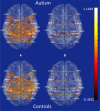Identification of neural connectivity signatures of autism using machine learning
- PMID: 24151458
- PMCID: PMC3798048
- DOI: 10.3389/fnhum.2013.00670
Identification of neural connectivity signatures of autism using machine learning
Abstract
Alterations in interregional neural connectivity have been suggested as a signature of the pathobiology of autism. There have been many reports of functional and anatomical connectivity being altered while individuals with autism are engaged in complex cognitive and social tasks. Although disrupted instantaneous correlation between cortical regions observed from functional MRI is considered to be an explanatory model for autism, the causal influence of a brain area on another (effective connectivity) is a vital link missing in these studies. The current study focuses on addressing this in an fMRI study of Theory-of-Mind (ToM) in 15 high-functioning adolescents and adults with autism and 15 typically developing control participants. Participants viewed a series of comic strip vignettes in the MRI scanner and were asked to choose the most logical end to the story from three alternatives, separately for trials involving physical and intentional causality. The mean time series, extracted from 18 activated regions of interest, were processed using a multivariate autoregressive model (MVAR) to obtain the causality matrices for each of the 30 participants. These causal connectivity weights, along with assessment scores, functional connectivity values, and fractional anisotropy obtained from DTI data for each participant, were submitted to a recursive cluster elimination based support vector machine classifier to determine the accuracy with which the classifier can predict a novel participant's group membership (autism or control). We found a maximum classification accuracy of 95.9% with 19 features which had the highest discriminative ability between the groups. All of the 19 features were effective connectivity paths, indicating that causal information may be critical in discriminating between autism and control groups. These effective connectivity paths were also found to be significantly greater in controls as compared to ASD participants and consisted predominantly of outputs from the fusiform face area and middle temporal gyrus indicating impaired connectivity in ASD participants, particularly in the social brain areas. These findings collectively point toward the fact that alterations in causal connectivity in the brain in ASD could serve as a potential non-invasive neuroimaging signature for autism.
Keywords: autism; classification; effective connectivity; fMRI; machine learning; theory-of-mind.
Figures






References
-
- Asperger H. (1944). Die ‘autistichen Psychopathen’ im Kindersalter, in Archive fur psychiatrie und Nervenkrankheiten, Vol. 117, Reprinted in Autism and Asperger syndrome, ed Frith U. (Cambridge: Cambridge University Press; ), 76–136
LinkOut - more resources
Full Text Sources
Other Literature Sources

